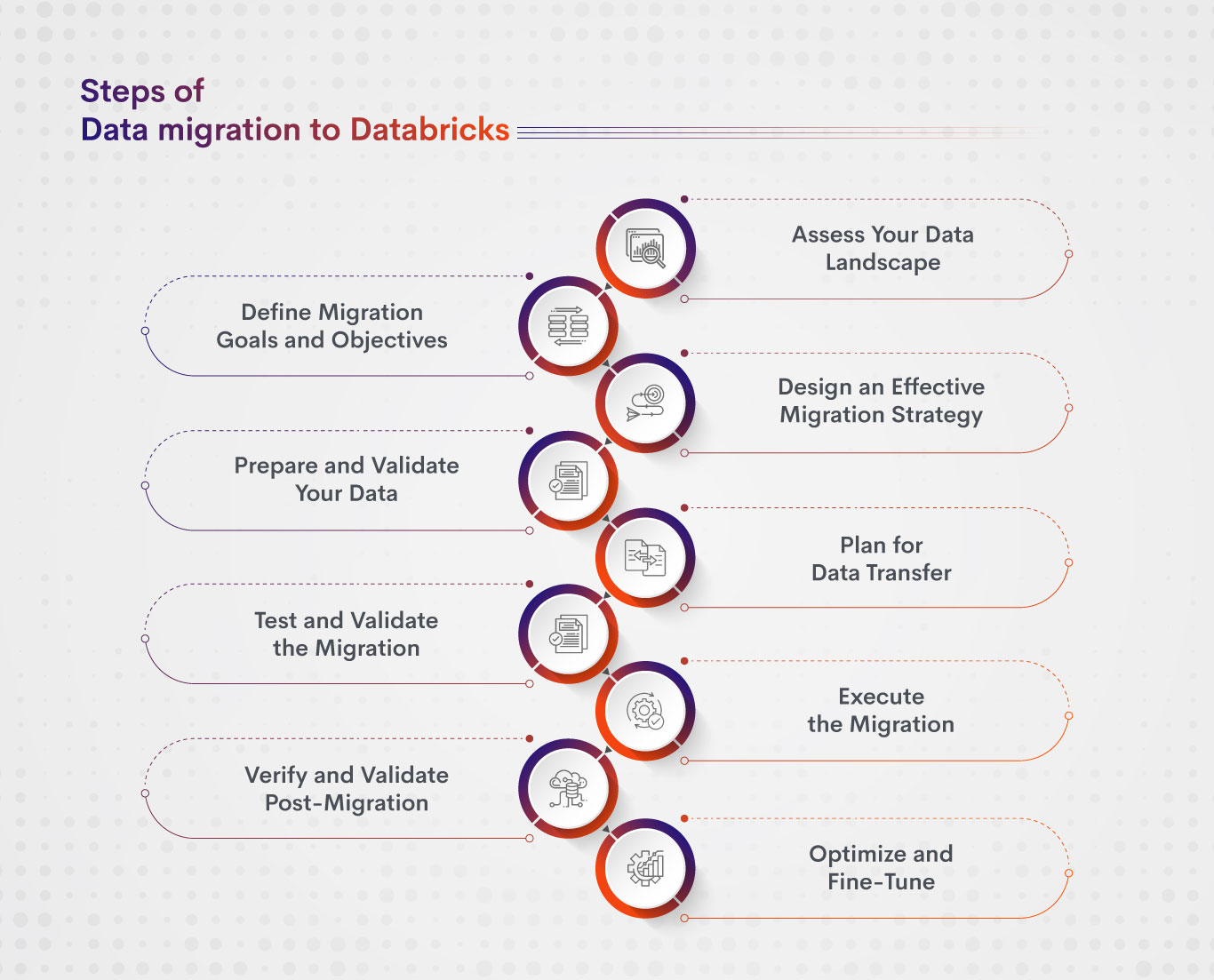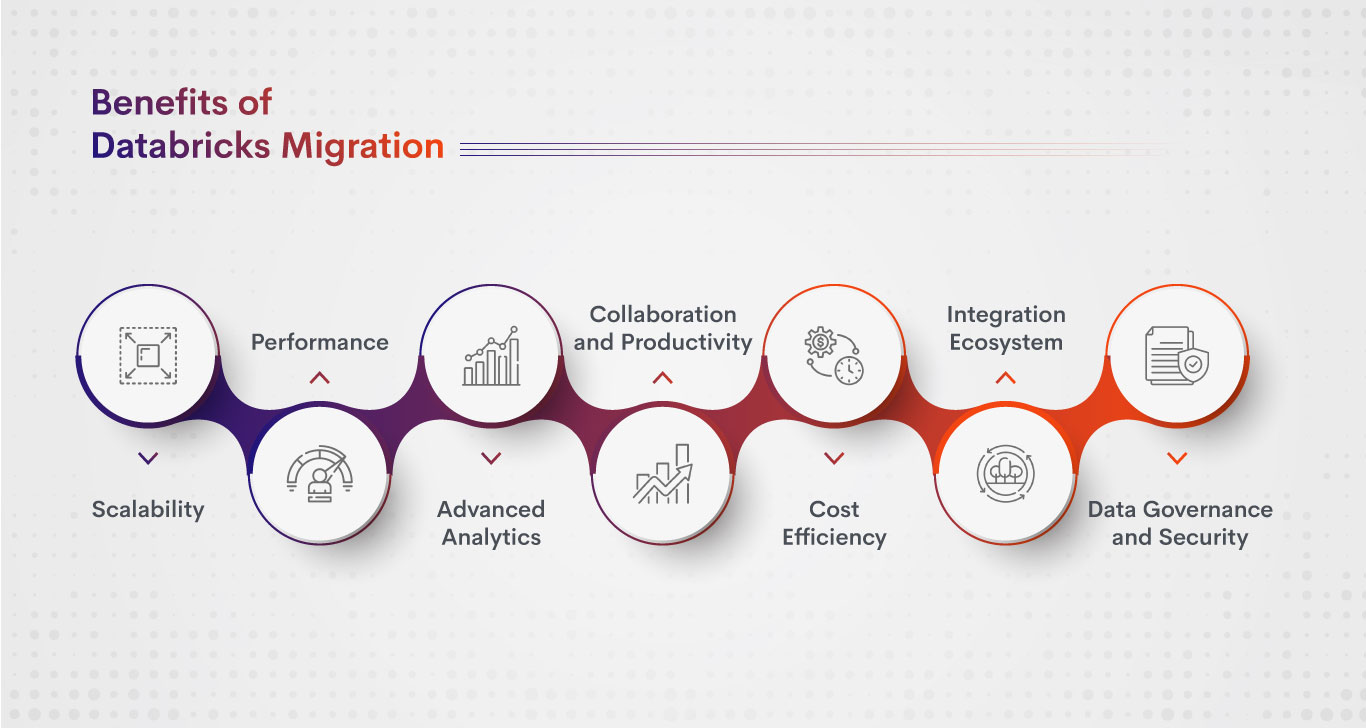- Blog
- June 23, 2023
Databricks Data Migration Steps and Benefits

- Blog
- June 23, 2023
Databricks Data Migration Steps and Benefits
Introduction:
In today’s data-driven ecosystem, organizations are tirelessly pursuing strategies to extract maximum value from their data and optimize their operations. Enter Databricks, the unified and collaborative platform for data engineering, data science, and business analytics. With Databricks, customers can streamline data workflows, accelerate experimentation, and facilitate seamless collaboration across teams. Leveraging its advanced capabilities, Databricks empowers businesses to unlock the true potential of their data, propelling them towards unparalleled success.
Let’s look at how migrating to Databricks might boost your business.
Migrating data to Databricks is a critical step in harnessing the power of advanced analytics and machine learning. However, successful data migration requires careful planning, execution, and attention to detail. Following are the essential steps to achieve a seamless and successful data migration to Databricks.
Steps of Data migration to Databricks:

Assess Your Data Landscape:
- Evaluate your existing data sources, formats, and structures.
- Identify any data dependencies or interconnections.
- Determine the data quality and consistency.
Define Migration Goals and Objectives:
- Clearly outline your migration goals and what you aim to achieve with Databricks.
- Define specific metrics for success, such as improved performance, enhanced analytics capabilities, or cost savings.
Design an Effective Migration Strategy:
- Select the appropriate migration approach based on your data volume and complexity.
- Determine whether a one-time bulk migration or incremental migration is more suitable.
- Plan for any necessary data transformations or schema changes during the migration process.
Prepare and Validate Your Data:
- Cleanse and transform your data as required, ensuring data integrity and consistency.
- Validate the data to identify and resolve any anomalies or inconsistencies.
- Ensure compatibility of data formats between source and target systems.
Plan for Data Transfer:
- Establish a secure and efficient data transfer mechanism.
- Consider network bandwidth, data encryption, and data transfer protocols.
- Optimize data transfer strategies, such as parallelization or incremental updates.
Test and Validate the Migration:
- Create a testing environment to validate the migration process.
- Test data integrity, accuracy, and completeness after migration.
- Perform validation checks against predefined success metrics.
Execute the Migration:
- Plan a maintenance timeframe to minimize downtime.
- Follow a well-defined migration plan, considering dependencies and data relationships.
- Monitor the migration process closely, ensuring data integrity and completeness.
Verify and Validate Post-Migration:
- Verify the data in Databricks to ensure it matches the source system.
- Validate that data pipelines, analytics jobs, and machine learning models are functioning correctly.
- Perform extensive testing of data processing and analytics workflows.
Optimize and Fine-Tune:
- Fine-tune your data pipelines and processing for optimal performance.
- Monitor and analyze the performance of your data workflows, making necessary adjustments.
- Continuously optimize your data architecture to maximize efficiency and accuracy.
The Data Lakes market, which had a valuation of USD 4.3 billion in 2022, is expected to experience substantial growth. Projections indicate that the industry will expand from USD 5.1385 billion in 2023 to reach USD 21.3687 billion by 2032, exhibiting a compound annual growth rate (CAGR) of 19.50% during the forecast period from 2023 to 2032.
Benefits of Databricks Migration

Migrating data to Databricks can offer several benefits for organizations. Here are some of the key advantages of data migration to Databricks:
-
Scalability:
Databricks is built on Apache Spark, a powerful distributed computing framework. It allows you to scale your data processing and analytics capabilities seamlessly. As your data volumes grow, Databricks can handle the increased workload by distributing the processing across a cluster of machines.
-
Performance:
Databricks leverages the distributed computing capabilities of Spark to deliver high-performance data processing. It can handle large datasets and complex analytics tasks efficiently, resulting in faster query execution and reduced processing time.
-
Advanced Analytics:
Databricks provides a unified analytics platform that integrates with various data sources, such as data lakes, data warehouses, and streaming data. This enables you to perform advanced analytics tasks, including machine learning, data exploration, and predictive modeling, all in one environment.
-
Collaboration and Productivity:
Databricks offers collaborative features that facilitate teamwork and increase productivity. Data scientists, data engineers, and analysts can work together within Databricks notebooks, sharing code, visualizations, and insights. This collaborative environment promotes knowledge sharing and accelerates data-driven decision-making.
-
Cost Efficiency:
Databricks provides a managed cloud service that eliminates the need for infrastructure management and maintenance. You can leverage the scalability of cloud resources and pay only for the resources you consume, optimizing costs based on your data processing needs.
-
Integration Ecosystem:
Databricks integrates well with other popular data and analytics tools and services. It can connect to various data sources, such as relational databases, cloud storage, and streaming platforms, allowing you to consolidate and analyze data from multiple sources seamlessly.
-
Data Governance and Security:
Databricks offers robust security features and built-in data governance capabilities. It provides fine-grained access controls, encryption, and auditing features to ensure the confidentiality and integrity of your data. Additionally, Databricks supports compliance standards, such as GDPR and HIPAA, making it suitable for organizations with strict regulatory requirements.
Conclusion:
Databricks offers a unified analytics platform that combines data engineering, data science, and business analytics, fostering collaboration and eliminating data silos. With its scalability, performance optimizations, and advanced analytics capabilities, Databricks enables businesses to leverage their data effectively, derive valuable insights, and drive innovation. By providing a seamless environment for data exploration, visualization, and machine learning, Databricks reduces guesswork and accelerates the time from data processing to production. Additionally, Databricks ensures data governance, security, and cost optimization, aligning with the needs of modern businesses.
Whether you are looking to accelerate your ETL processes, build sophisticated machine learning models, or gain deeper insights from your data lakes, Databricks data migration can be a game-changer for your organization.
By embracing Databricks, organizations can position themselves for a better future growth trajectory, leveraging the power of data to make informed decisions, stay competitive, and unlock new opportunities in an increasingly data-driven world. Opt Databricks to supercharge your business processes, reduce guesswork, and unlock new opportunities for growth and innovation.
Join us as we delve into the world of Databricks data migration and discover how it can revolutionize your business. Let’s embark on a journey to harness the true potential of your data and propel your organization toward greater success.




